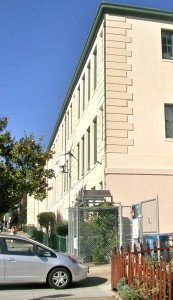Oops — No Wind
January 21st, 2013If we learn from our mistakes, students at Sanchez School will certainly benefit from the placement of this fence-top wind turbine. As anyone walking by could tell you, the generator would do better on top of this 40-foot edifice than at the sidewalk.
But would that be enough? Industry rule of thumb suggests placing turbines 30-feet over anything within a 500-foot radius. That gets you into the laminar winds above typical rooftop turbulence. It takes some expense though, and introduces structural and vibration-related building stresses, with related noise potentially amplified through the roof diaphragm.
And even at that elevation, a wind generator may not yield much. Say the turbine has a rated capacity of 1kW in 10-mph wind (though winds below 5-mph may not affect the rotors), the average wind is 10-mph, and we generously assume this site, downhill and leeward of Twin Peaks, yields a 10% capacity factor. Theoretically that would still be 100W, but real-world testing of micro wind generators is yielding results of only a fraction of manufacturer claims. Domestic-scale photovoltaic panels are producing more output, at less cost, and with a fraction of the maintenance wind generators require.
Wind power will certainly be in our future, but it’s going to be from large arrays, in open countryside, between migratory routes, and far from your rooftop.










